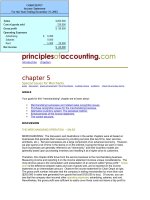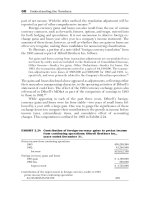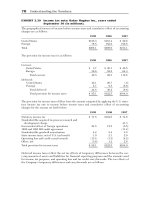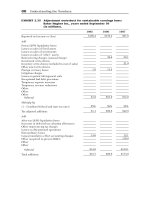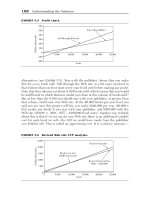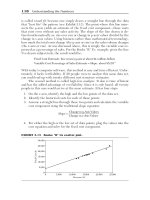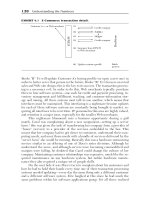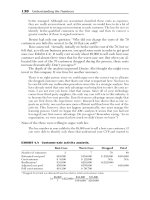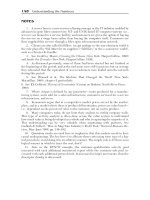Tiếng anh chuyên ngành Mindmap
Bạn đang xem bản rút gọn của tài liệu. Xem và tải ngay bản đầy đủ của tài liệu tại đây (347.62 KB, 22 trang )
Unit 1: Economics
Last main idea: Three
Second main idea: Two
First main idea: What’s
economics theories
type main of economics.
economics ?
• “Classical school” by Adam Smile.
• “Marxism” by Kart Marx.
• “Keynesian school” by Keynes.
All there three economics theories
describe the roles of government in the
market and how people behave within
market.
• Micro-economics
focuses
on
the
action individuals and industries.
• Macro-economic
economics
activity
analyses
of
an
• Economics is the study of how people
choose to use resource to improve
the
entire
country or international marketplace.
their well-being.
Question
Unit 1: Economics
1 What does the term “well being” mean?
Unit 2:Economics systems
1 What is marker economy?
Well-being is the satisfaction that people from product and Market economy is an economics system in which market is
services they chooses to use.
2 What does micro-economics study?
regulated by the Law of supply and demand.
2 How does the government influence the economy in the
Micro-economics focuses on the actions individuals and
industries.
market economy?
In the market economy, there’s no direct government
3 What does macro-economic study?
intervention. The government influences the economic situation.
Macro-economic analyses the economics activity of an entire 3 What is a planned economy?
country or international marketplace.
Planed economy is an economic system in which the structure
4 Who are economists?
of market is planned by the state and production and
Economist is the people who study economics to answer
consumption quotas are fixed beforehand.
questions about how people and nations can maximize their 4 What’s GDP?
well-being.
GDP stands for Gross Domestic Product is the value of goods
5 In general, how can people benefit from study economics?
Studying economics can help one understand human thought 5
and behavior.
and services produced by a country in a year.
Unit 3: Micro-economic
Last main idea: Three main
themes of micro-economics.
• The first main theme is “making optimal • In
trade-off”.
Consumers, workers and firms have •
limited resource.
Therefore they have to make optimal
trade-offs to maximize their well-being.
• The second theme is “the role of price”
All the trade-off made by consumers,
workers and firms are based on prices.
• The last main them is “the center role of
market”
The interaction of consumers, workers
and firms in the market determine the
price of a good
First main idea: What’s
micro-economics about?
Second main idea:
Allocation of resource.
a
planned
economy
allocation • Micro-economic is about limits and the
decisions are made by the Government.
In
a
market
economy
allocation •
decisions are made by consumers,
workers and firms.
way to make the most of these limits.
In other word, it’s about allocation of
scare resource.
Question
1. What does the term “trade-off” mean?
6. Give some on examples explaining the trade-off made by
firms?
2. What can you learn from the consumer theory?
Consumer theory describes how consumers can maximize their
well-being by making optimal trade-off.
3. What does the theory of the firm indicate?
The theories of firms indicate how firms can make the best
trade-off to maximize the profits.
4. Give some on examples explaining the trade-off made by
consumers?
Some example of trade-off made by consumers: consumers
have to trade-off current consumption for future consumption;
the purchase of some goods with the purchase of others.
5. Give some on examples explaining the trade-off made by
workers?
Some example of trade-off made by workers: workers have to
trade-off working now with continued education; labor with
leisure and made trade-off in the choice of employment.
Some example of trade-off made by firms: firms have to tradeoff hiring more workers with building more factories, firms also
have to made optimal trade-off in tern of finance resource.
7. What are their important themes of micro-economic?
There are three main themes of micro-economic
• The first theme is “making optimal trade-off”.
Consumers, workers and firms have limited resource.
Therefore they have to make optimal trade-offs to maximize
their well-being.
• The second theme is “the role of price”
All the trade-off made by consumers, workers and firms are
based on prices.
• The last main them is “the center role of market”
The interaction of consumers, workers and firms in the market
determine the price of a good
Unit 4: Macro-economic
Last main idea: The difference
between macro-economic and
micro-economic.
First main idea: What’s macroeconomic about?
Second main idea: two macroeconomic policies.
• Micro-economic is the study of decisions There are
Macro-economic
look
at
overall
controls
economic trends such as inflation,
regarding allocation of resource and
Government revenue and spending. It’s
economic growth employment levels and
prices of the goods and services.
in the hand of the Ministry of finance.
balance of payment.
made by people and the business
•
• Fiscal
•
Macro-economic studies the behavior of
the entire industry and entire economy.
policy
which
• Monetary policy which controls a
nation’s money supply is supervised by
each country’s Central Bank.
The main objectives of these economic
policies are to promote economic growth
and keep inflation under controls.
Question:
1. What are two major macro-economic policies?
Fiscal policy which controls Government revenue and spending.
It’s in the hand of the Ministry of finance.
Monetary policy which controls a nation’s money supply is
supervised by each country’s Central Bank.
2. What are main tool of monetary policy?
There are changing:
Reserve requirement.
The discount rate.
Open-market operation.
3. What are main tool of fiscal policy?
There are taxation and government spending.
4. What is the different between micro-economic and macro-e?
Micro-economic is the study of decisions made by people and
the business regarding allocation of resource and prices of the
goods and services.
Macro-economic studies the behavior of the entire industry and
entire economy
5. What’s the goal of macro-e?
Macro-economic look at overall economic trends such as
inflation, economic growth employment levels and balance of
payment
6. What’s fiscal policy?
Fiscal policy is the government policy which controls
government taxation and spending.
7. Why is it said that micro-e and macro-e are interdependent
and complement on other?
While there two studies of economics appear to be different,
they are actually interdependent and complement are another
since there are many overlapping issues between the two fields.
Unit 5: Demand and supply
Last main idea: Equilibrium
Second main idea: Description
of supply curve.
First main idea: Description of
demand curve.
?
• The market will be in equilibrium at the • Price and shift factors can influence • Price and shift factors can influence
price where the quantity demanded
seller’s behavior shift factors include
buyer’s behavior shift factors include
equals quantity supplied.
technology, tax, expectation, price of
income, taste, expectation or price of
input.
other goods.
• On the graph, If there’s a change in • On the graph, If there’s a change in
price, the will be a movement a long a
price, the will be a movement a long a
given supply curve.
given demand curve.
• On the graph, if there’s a change in shift • On the graph, if there’s a change in shift
factors, the entire supply curve will shift
factors, the entire demand curve will
to the right or shift in the left.
shift to the right or shift in the left.
Question
1. What is the definition of demand?
Demand is quantity of a good or a service that buyers are
willing and able to purchase at various prices.
2. What is the definition between demand and quantity
demanded?
Demand is quantity of a good or a service that buyers are
willing and able to purchase at various prices.
Quantity demanded is quantity of a good or a services that
buyer are willing and able to purchase at a certain/ particular
price.
3. What is the definition of supply?
Supply is quantity of a good or a service that sellers wish to sell
at various prices.
4. What is the definition between supply and quantity
supplied?
Supply is quantity of a good or a service that sellers wish to sell
at various prices.
Quantity supplied is quantity of a good or a services that seller
wish to sell at certain/particular prices.
5. How to price of a good influence its demand?
If the price of a good or a service increases, the quantity that
buyer will purchase will decreases.
If the price of a good or a service decreases, the quantity that
buyer will purchase will increases.
6. How to price of a good influence its supply?
If the price of a good or a service increases, the seller will
produce less and the quantity supplied will decreases
Unit 6: Public
Second main idea: Federal debts.
First main idea: Two main sources of
federal budget / revenue.
• Debt held by public: is the total amount which government • Tax revenue come from three major sources: income taxes paid
owes to the creditors in general public.
General public include foreign individuals and foreign
countries.
by individual, payroll taxes paid by workers and employers and
corporate income taxes paid by businesses.
Income taxes and corporate income taxes become “federal
funds” and payroll taxes become “trust fund”.
• Debt held by federal accounts is the amount of money the
treasury borrows from itself.
(such as from trust funds)
• Another major sources of federal revenue is “borrowing” the
US treasury borrows money by issuing bonds and other types of
securities
Question
6. What’s debt held by the public?
1. What type of taxes contributes the largest proportion of tax
• Debt held by public: is the total amount which government
revenues?
owes to the creditors in general public.
Main source of tax revenues.
General public include foreign individuals and foreign
Income taxes paid by individual.
countries.
Payroll taxes paid by workers and employers.
Corporate income taxes paid by businesses.
2. By what way does the treasury borrow money?
US treasury borrowing money by issuing bonds and other types
of securities.
3. Who does the federal government owe money to?
Government owes money to its citizens, foreign investors,
foreign countries or other international financial institutions.
4. What’s payroll tax?
Payroll tax is a tax imposed on salaries or wages of employers.
5. What’s debt held by federal accounts?
Debt held by federal accounts is the amount of money the
treasury borrows from itself.
Unit 7: Fiscal policy
Last main idea: Factors
affecting decision on fiscal
policy.
Including
• Inside factor include:
Level economic growth.
Level of unemployment or inflation.
Ways to finance deficits.
Political consideration.
• Outside factors include:
Fiscal policies of other countries.
Requirements of ITM or World Bank.
Second main idea: two types
of fiscal policy.
First main idea: The direct
influence of Gov sending and
taxation on the performance of
the economy.
• Fiscal policy is Gov policy related to • One way for Gov to finance deficits
taxation and public spending.
when Gov spends more than it receives
• Expansionary fiscal policy: is when
is “deficit spending” which is the
taxation is reduced or public spending is
spending funds obtained by borrowing or
increased to stimulate total spending and
printing money instead of taxation.
economic growth.
• Contractionary fiscal policy: is when
taxation is increased or public spending
is reduced to restrict demand and slow
down the economy.
Question
1. When does Gov decision or contractionary policy?
Contractionary when taxation is increased public spending is
reduced to restrict demand and slow down the economy.
2. What factors should be considered in making decision on
the fiscal policy?
Factors should be considered in making decision on the fiscal
policy including
• Inside factor include:
Level economic growth.
Level of unemployment or inflation.
Ways to finance deficits.
Political consideration.
• Outside factors include:
Fiscal policies of other countries.
Requirements of ITM or World Bank
3. What are the Gov’s major economic policies mentioned
above?
the Gov’s major economic policies mentioned above are
• Fiscal policy which controls Government revenue and
spending. It’s in the hand of the Ministry of finance.
• Monetary policy which controls a nation’s money supply is
supervised by each country’s Central Bank.
Unit 8: Taxations
First main idea: Main functions
taxations
• To raise revenue to finance government expenditure.
• To encourage capital investment.
Second main idea: advantages
and disadvantages of tax system.
• There is a lot of debates as to the fairness of tax system.
• To redistribute wealth.
Third main idea: tax evasion.
• The higher the tax rate, the more people are tempted to cheat.
Last main idea: tax avoidance.
• There are different ways to avoid taxes.
• Ways of tax evasions are self employment or doing undeclared “ Loopholes in the tax Law”
part-time job.
“Tax shelters”
“Tax-deductible”
“Making of tax loss”
“Tax havens”
“Laundering money”
Question
1. What are main functions of taxes?
Main functions of taxes are to raise revenue to finance
government expenditure, to encourage capital investment, to
redistribute wealth.
2. What are tax havens?
Tax havens are countries where taxes are low.
3. What is a progressive tax?
A progressive tax is a tax levied at a higher rate on higher
incomes.
4. What is excise tax?
Excise tax is a tax levied on some special goods to dissuade
people from consuming them.
5. What is tax-deductible?
7. What is capital gain tax?
Capital gain tax is a tax levied on profits made by selling assets.
8. What is corporate income tax?
Corporate income tax is a direct tax levied o the profits and is
paid by businesses.
9. What is capital transfer tax?
Capital transfer tax is a tax levied on gifts or inheritances over a
certain value.
10. What is payroll tax?
Payroll tax is a tax paid jointly by worker and employers.
11.What do Criminal organizations tend to do to disguise the
origin of the money?
Criminal Organizations, meanwhile, ten to pass money through
a series of companies in very complicate transactions in order to
disguise its origin from tax inspectors- and the police; this is
6. What is VAT tax?
VAT tax is a tax collected at each stage of production excluding
the already-taxed costs from previous stages.
known as laundering money.
Unit 10: Insurance
Last main idea: Different
between gambling contracts
and insurance contracts.
Second main idea: The
operation insurance system.
First main idea: Definition
of insurance.
• An insurance contract is a special class • An insurance system redistributes the • Insurance is a financial arrangement that
of contract in which the Law requires
cost of losses by collecting a premium
redistributes the costs of unexpected
the parties (the insured and the insurer)
payment from every participant in the
losses.
to excise good faith towards each other
system.
while the Law will not enforce a
gambling contract.
• In exchange for that, the insured receives
a promise from the insurance system to
be compensated in the event of losses.
• Is no loss occurs, value has still been
receives.
Question
1. What is compensation?
Compensation is the amount of money that the insurer pays for
the insured when a loss actually occurs.
2. What is insurance premium?
Insurance premium is the amount of money that the insured pay
the insurer.
3. What is an insurance policy?
An insurance policy is a finance arrangement signed between an
insurance company and the insured.
4. What does the insurance receive when a loss occur?
The insurance receive a promise from the insurance system to
be compensated in the event of losses.
5. What is insurance in financial definition?
Insurance is a financial arrangement that redistributes the costs
of unexpected losses.
Unit 11: Money and its function.
Last main idea: Two types of
money.
• Commodity money.
Second main idea: Four
main function of money.
• Money as a medium of exchange.
Commodity money is a useful good that Money is the most common medium
serves as a medium exchange.
The value of commodity money is about
through which people exchange goods
and services.
equal to the value of the material • Money as a measure of value.
contained in it.
Money measure of value in its units of
• Token money.
accounts (such as USD, Pound, VND...).
Token money is a means of payment • Money as a store of value.
whose value or purchasing power as Money is a store of value because it can
money greatly exceeds its cost of
be used to make purchases in the future.
production or value in uses other than as
But it’s not of good store of value.
money.
• Money as a standard of deferred
payments.
When you buy something but do not pay
for it immediately, your payment is
expressed in terms of money to be paid
in the future.
First main idea: The concept
of money.
• Money is a commodity accepted by
general
consent
as
economic exchange.
a
medium
of
Question
1. What is the concept of money?
Money is a commodity accepted by general consent as a
medium of economic exchange.
2. What are the functions of money?
Function of money are:
Money as a medium of exchange.
Money as a standard of deferred payments.
Money as a store of value
Money as a measure of value.
3. What is a medium of exchange?
A medium of exchange is anything that is widely accepted in
payment for goods and services and in settlement of debts.
4. How is money used as a store of value?
Money is used as a store of value because money is used to
make purchases in the future.
5. What is a measure of value?
Measure of value is the unit is which prices are quoted and
accounts are kept.
6. What are two main types of money?
Two main types of money are commodity money and token
money.
Second main idea: Two types
of monetary policy.
First main idea: Three main
tools of monetary policy.
• Expansionary monetary policy.
• Changing the reserve requirement.
Monetary policy is expansionary if the central bank lowers
Reserve requirement are the minimum amount of reserves that
reserve requirement, decrease the discount rate and buy Gov
bonds to increase the money supply in the economy.
banks must have and sat by FED (Federal Reserve System).
By changing reserve requirement, FED can increase and
decrease the money supply.
• Restrictive monetary policy.
• Changing the discount rate.
Monetary policy is restrictive if the central bank raises the
Discount rate is the rate of interest the FED charges for those
reserve requirements, increase the discount rate or sell Gov
bonds in order to reduce the money supply in the economy.
loans.
By changing discount rate, FED can expand or contract the
money supply.
• Open market operation.
Open market operations are the FED buying and selling Gov
bonds.
To increase the money supply, the FED buys bonds. To
decrease the money supply, the FED sells bonds.
Question
1. What is expansionary monetary policy?
Monetary policy is expansionary if the central bank lowers
4. What is reserve requirement?
Reserve requirement are the minimum amount of reserves that
banks must have and sat by FED (Federal Reserve System).
reserve requirement, decrease the discount rate and buy Gov
bonds to increase the money supply in the economy
5. What are three main tools of monetary policy?
Three main tools of monetary policy are:
2. What is restriction monetary policy?
Monetary policy is restrictive if the central bank raises the
reserve requirements, increase the discount rate or sell Gov
bonds in order to reduce the money supply in the economy.
3. What is discount rate?
Discount rate is the rate of interest the FED charges for those
loans.
Changing the discount rate.
Changing the reserve requirement.
Open market operation.
UNIT 14: THE FOREIGN ECHANGE
MARKET
1ST: DEFINITION
1. Foreign exchange market is a market
in which national currencies are
traded ( It’s an OTC-market
transaction are made through phones
or computer)
(reason for the growth:
• The growth world trade
• The expansion of international capital
flows)
2ND : 2 TYPES OF TRANSACTION IN
FOREIGN EXCHANGE MARKET
2. Spot transaction are undertaken
for actual exchange of currencies
(2 business day later)
3. Forward transaction are the
buying and selling currencies in
the forward market to avoid
exchange rate fluctuation. The
delivery date can be one year or
more
3RD : 3 TYPES OF PARTICIPATE IN
FOREIGN ECHANGE MARKET
4. - Customer such as multinational
companies they need foreign
currencies for cross-border trade
or investment
- Bank as maket makers. They
quote buying and selling rate
for currencies ( they earn
profits from the difference
between buying and selling
rate)
- Brokers act as intermediaries
between banks. They charge
commission for their service
Unit 15: The Financial markets
1. What’s the debt market ?
- It is a financial market in which
short-tern debt instrument (with
maturity of less than one year)
are traded.
2. What’s equity market?
-it is a financial market in with
long-tern debt instrument ( with
maturity of 10 years or more)
are traded.
3. what’s OTC market?
An OTC market is a financial market in
which securities and other financial
instruments (such as currencies, certificates
of deposit) are trade over-the-counter
4.what’s stock exchange?
Stock exchange is a financial market in
which securities (bonds & stocks) are traded
in one central location
5. What’s primary market & secondary
market?
+ a primary market is a financial
market in which new issues of share
or bonds are sold to initial buyers.
+ a secondary market is a financial
market in which previously-issues
securities are resold.
